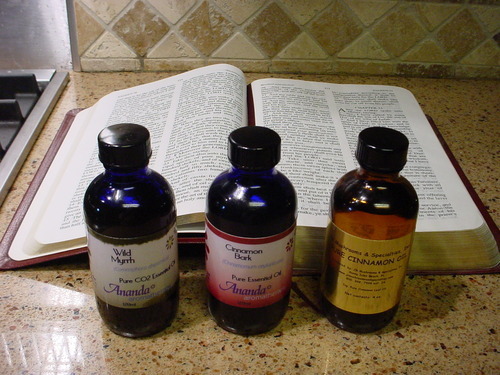Annointing Oil – an Idol?
A talisman is an object that is believed to hold magical or mystical powers. We all subscribe to various talismans – I think.
It can be something very simple, such as wearing the same shirt on a special day. Tiger Woods is one who always wears red on the Sundays of each golf tournament, believing it brings good luck or positive karma. We hear of athletes who go through a routine each time up to bat or before going onto the field. They kiss a helmet, slap a sign coming out of a locker room or rub the head of a mascot. All can be considered emblems or objects that presumably help us accomplish our desires.
David Morgan in The Sacred Gaze speaks of this investment we have with objects and how we garner spiritual meaning, protection or miraculous power through our personal associations ascribed to these images. The word covenant is used to describe the “gaze that joins viewer and image in a social relation.” They are built upon trust or truth and although the viewer knows that these are symbols, they are really much, much more.
In the author’s lists of conditions upon which this trust is built, he initially lists the fact that an image is accepted as true and real because it encases the will of the viewer. Secondly, it is viewed as true based upon the authority of someone, or, that it passes a sort of “litmus test” that we’ve been taught. Finally, we believe, simply, because the outcome is the desired state in which we would like to find ourselves.

I believe this formula can be treacherous to the Christian Church if not handled properly. We sometimes, as evangelicals, deride other more traditional and older denominations because of their icons, statues and symbolism or illustrative architecture. I’ve heard people cautioned when appropriating these elements because of a tendency to use them as idols. But I see this happening to evangelicals as well – when the list of covenant definitions that Morgan proposes are applied to some of our practices.
I will use anointing oil as an example. My evangelical church teaches us to stay away from idols and yet, once every two months, a healing service with anointing oil is scheduled. We are instructed as pastors to carefully outline the cross on the petitioner’s forehead with the oil.
We understand this action as a symbol of God’s healing power, and the oil not as magical, but as symbolic. Although we quote the James passage as our directive, we know God heals with or without oil outlined as a cross on the forehead. But to many, this has become a talisman or a sacred visual covenant.
Using Morgan’s conditions for trust, the anointing of oil is “magical” to the believer because; 1) It bears the will of our community – it aligns with who we are, a church that believes in transformation. 2) The one in authority (Pastor) reads the authoritative scripture, where it speaks of healing. 3) It satisfies previous experiences – we’ve heard testimonies of healings, and last, 4) It represents the desirable state of experience – we want to believe that God heals all of our hurts and ailments and makes everything OK.
While true somewhat, when the object, through the Sacred Gaze, becomes more than it should and becomes a covenant or talisman, I believe we are in danger of doing a disservice to God and to his church.
But as Morgan states, “belief, in other words, does not exist in an abstract. Belief happens in and through things and what people do with them.” If the act of seeing is caught up in the element rather than the object, the person or the idea the element is pointing to, therein lays the problem.
Leave a Reply
You must be logged in to post a comment.